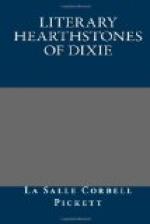On the grounds east of the college buildings stands the Tulip Tree which sheltered the first settlers of Annapolis in 1649, and may have hidden away in the memory-cells of its stanch old heart reminiscences of a time when a bluff old Latin sailor, with more ambition in his soul than geography in his head, unwittingly blundered onto a New World. Whatever may be its recollections, it has sturdily weathered the storms of centuries, surviving the tempests hurled against it by Nature and the poetry launched upon it by Man. It has been known by the name of the “Treaty Tree,” from a tradition that in the shade of its branches the treaty with the Susquehannoghs was signed in 1652. In 1825 General La Fayette was entertained under its spreading boughs, and it has since extended hospitable arms over many a patriotic celebration.
In “the antiente citie” Francis Scott Key found many things which appealed to his patriotic soul. On the State House hill was the old cannon brought to Maryland by Lord Baltimore’s colony and rescued from a protracted bath in St. Mary’s River to take its place among the many relics of history which make Annapolis the repository of old stories tinged by time and fancy with a mystic coloring of superstition. He lived in the old “Carvel House,” erected by Dr. Upton Scott on Shipwright Street. Not far away was the “Peggy Stewart” dwelling, overlooking the harbor where the owner of the unfortunate Peggy Stewart, named for the mistress of the mansion, was forced by the revolutionary citizens of Annapolis, perhaps incited by an over-zealous enthusiasm but with good intentions, to burn his ship in penalty for having paid the tax on its cargo of tea.
If Francis Key had a taste for the supernatural, there was ample opportunity for its gratification in this haven of tradition. He may have seen the headless man who was accustomed to walk down Green Street to Market Space, with what intention was never divulged. Every old house had its ghost, handed down through the generations, as necessary a piece of furniture as the tester-bed or the sideboard. Perhaps not all of these mysterious visitants were as quiet as the shadowy lady of the Brice house, who would glide softly in at the hour of gloaming and, with her head on her hand, lean against the mantel, look sadly into the faces of the occupants of the room, and vanish without a sound—of course, it is undeniable that Annapolis would have only well-bred ghosts.
After graduation from St. John’s, in that famous class known as the “Tenth Legion” because of its brilliancy, Francis Scott Key studied law in the office of his uncle, Philip Barton Key, in Annapolis, where his special chum was Roger Brooke Taney, who persuaded him to begin the practice of his profession in Frederick City. In 1801 the youthful advocate opened his law office in the town from which the Revolutionary Key had marched away to Boston to join Colonel Washington’s troops. Francis Key invited his friend to visit Terra Rubra with him, and Mr. Taney found the old plantation home so fascinating that many visits followed. Soon there was a wedding at beautiful Terra Rubra, when pretty, graceful Ann Key became the wife of the future Chief Justice of the United States Supreme Court.




